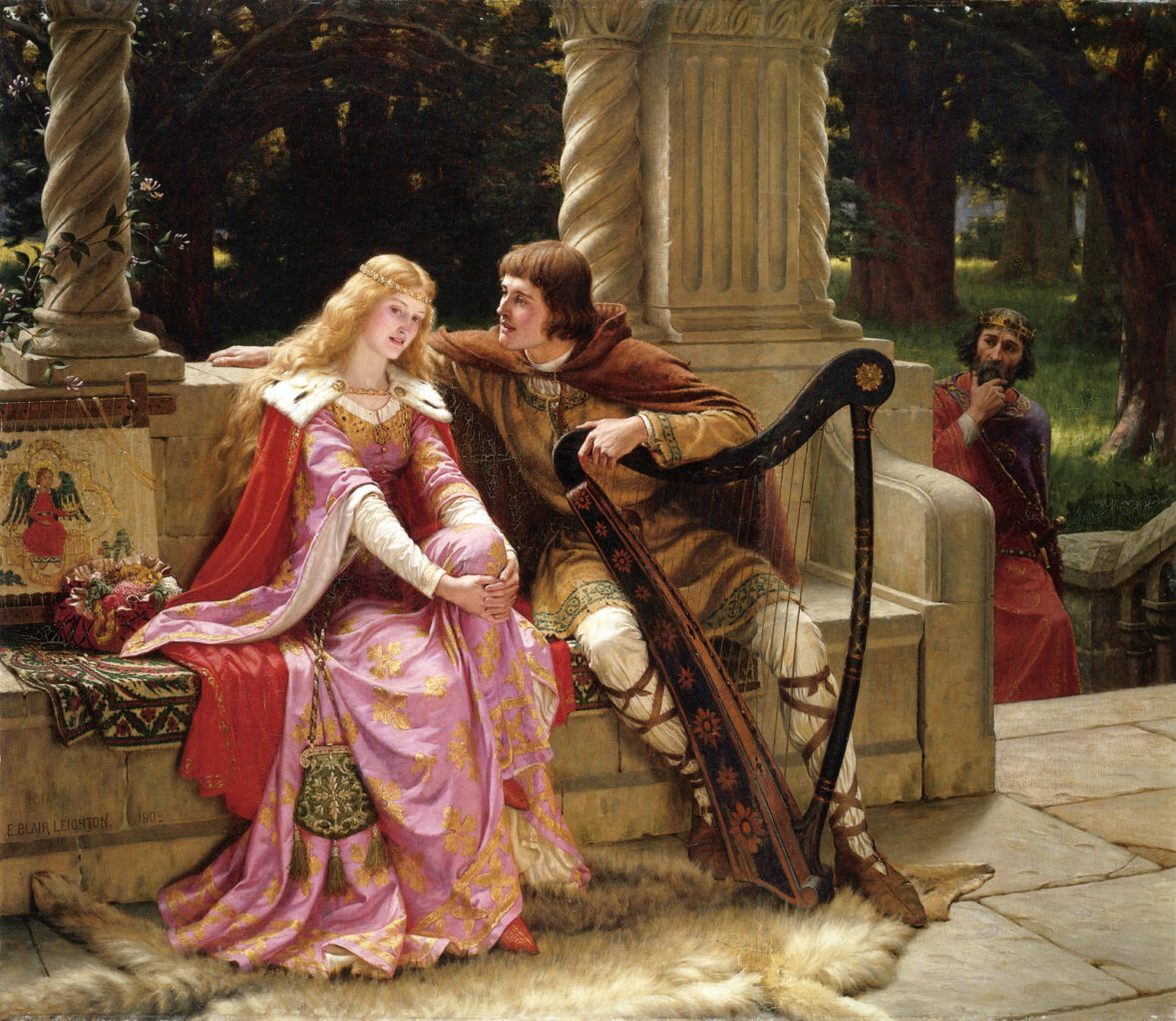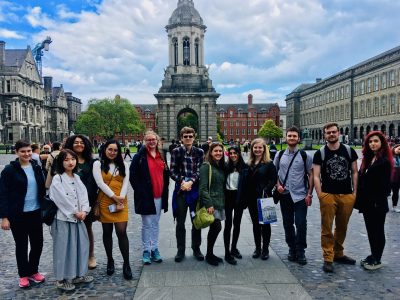A coming conference at the University of St. Michael’s College entitled The Other Sister: New Research on Non-Cloistered Religious Women (1100-1800), will shine an overdue light on the unique lives of women who lived demonstrably religious but non-cloistered lives outside of traditional monastic structures during the Middle Ages and beyond.
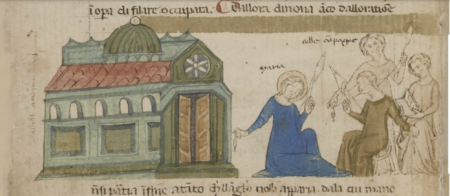
The regional names assigned to these single or widowed women sound today like exotic jewels: beguines, bizzoche, pinzochere are just a few examples, but often stemmed from very specific roles these women filled. And while there is ample evidence of their existence and the charitable work they conducted, they have often been overlooked in scholarly discussions because they fell between the more traditional lives of nuns and married women. One of the chief aims of the conference is to discuss where and how they fit into their times, both within the church as well as within society.
In part, says Dr. Alison More, who is one of the conference organizers and Associate Professor, Comper Professorship of Mediaeval Studies at St. Michael’s, one of the challenges these women faced is that since they didn’t lead traditional lives — monastic, wearing habits, for example — the church and society were unsure of exactly where they fit in and, thus, they were treated with suspicion, even while answering great societal needs.
“They’re not married and they are not nuns…There was a fear of sexual misbehaviour, heresy, or general misconduct” More says, noting that since these women were not the same as nuns, who were immersed in a cloistered, religious life of prayer, “therefore they must be up to no good.”
In fact, these women, often funded by wealthy widows or bequests, lived in loose-knit communities. They took on specific, practical roles, for example, as “sisters of the soup,” feeding the hungry, as hospice sisters or in the Low Countries, engaging in the cloth trade to fund charitable work, More says. They also served in North America, including New France, for example, educating children.
“Women were doing what needed to be done,” she says, noting that these women were asking themselves “how can I imitate Christ in an urban setting,” aware of the suffering and needs they witnessed in their own communities and wanting to respond.

“These women played a significant role in society” and managed to work within conventions by applying rules in creative ways, More adds.
The Other Sister conference, which runs May 18-20 at St. Michael’s, is a collaborative, international effort organized by University of Toronto mediaeval scholars, including Drs. More and Isabelle Cochelin and a group of graduate students, as well as Drs. Mary Doyno of California State University Sacramento and Patricia Stoop of Antwerp University.
The conference, More explains, grew out of an informal research group of academics pleased to find others working in the same field. During COVID, the group would hold Zoom workshops, where new research was summarized. Once the group neared 50 members it made sense to take the conversations to meeting in person, she says.
You can register for The Other Sister in person or via Zoom by contacting tos2023conference@gmail.com.
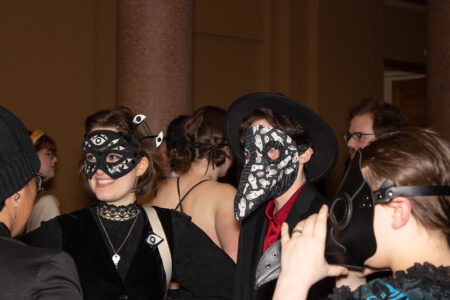
St. Michael’s has long been recognized for its Mediaeval Studies program, which includes an impressive history of renowned professors, rich resources, and an exciting interdisciplinary and experiential approach to learning. The program is an ideal example of the humanistic values of liberal education that reflect Catholic education at its best.
Life as a Mediaeval Studies student is not only enhanced by small class sizes and access to professors, but it is further enriched via the Mediaeval Studies Undergraduate Society (MSUS), which provides regular social and academic activities for students throughout the school year. MSUS offers academic assistance and peer mentoring within the field of medieval studies and hosts campus-wide events such medieval feasts, lectures, workshops, movie nights and a masquerade ball.
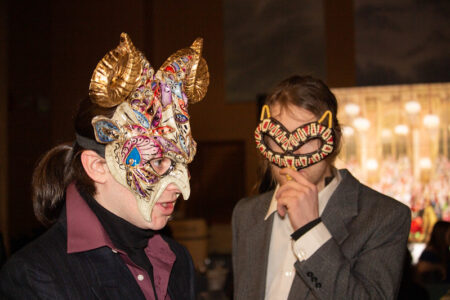
This year, the highly anticipated (and since sold out!) masquerade ball returned after a Covid-induced hiatus. Students from the Medieval Studies and Celtic Studies Undergraduate Society joined faculty and friends in Father Madden hall to celebrate a return to campus and “party like it’s 999.”
All photos by Ali Akberali are available on Flickr, and the playlist is available on Spotify.
- https://www.flickr.com/photos/196462221@N02/sets/72177720305762013/
- https://open.spotify.com/playlist/7ispyXg3GlnmsTuMjKwRFe?si=90a13bda11f04179
Jacqueline Murray has been a Professor of History at the University of Guelph since September 2001, where she was also Dean of Arts. Previously she was a member of the Department of History at the University of Windsor. In 1987, Jacqueline graduated from the University of Toronto with a Doctor of Philosophy in Medieval Studies. Her research specializes in sex, gender, and sexuality, masculinities and embodiment, as well as marriage and family in premodern Europe. She is a Visiting Fellow at St Michael’s College from 2022-2024.
My first connection to St Mike’s started even before I arrived in Toronto. As an undergrad at UBC, I became fascinated with the Middle Ages. Medieval history became a huge part of my life, my passion and eventually my vocation. In those days, medieval history revolved around kings and popes; politics and religion. Then, Father Michael Sheehan from the Pontifical Institute of Mediaeval Studies (PIMS) visited UBC and delivered a series of lectures about the lives of ordinary medieval people, and particularly about marriage and the family.
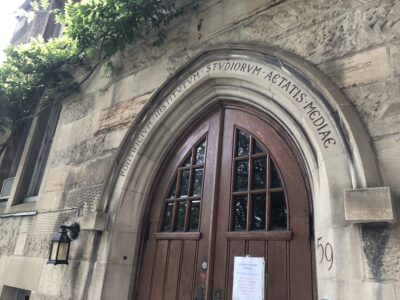
He opened my eyes to a completely new approach to the study of the Middle Ages and I knew I wanted to be part of it. This was in the 1970s when feminism was challenging society and women’s history was just emerging. I wanted to integrate these important perspectives into my study of the Middle Ages, so I decided to do my honours thesis on how women were treated in a medieval law code. I had the chance to speak with Father Sheehan about the feasibility of this research and he was encouraging. I think his endorsement helped convince my supervisor, the great political historian, Janos Bak, to let me pursue a topic that was considered rather daring at the time!
My encounter with Father Sheehan changed my life forever. I came to U of T to pursue graduate work with him and my first steps in Toronto were across the St Mike’s quad to Father Sheehan’s office. While I originally intended to follow his lead and study marriage and the family, to my surprise (and to Fr Sheehan’s!!!) the medieval sources led me in a different direction: to the church’s understanding of human sexuality. These same sources led me to my current research on medieval masculinity, a topic central to understanding the history of the Middle Ages.
I consider St Mike’s and PIMS to be an intellectual home. From my days as a graduate student, I have had the opportunity to really connect with the thriving medieval community and to hone my skills as an historian. These days, I am using a broad array of sources including hagiography, sermons, medical texts, and chronicles, in other words, historical, religious, and theological texts to explore human sexuality, masculinity, and male embodiment– that is men’s experience of having a human body that is sexed male. I am finding this research helps to illuminate medieval understandings of chastity, misogyny, and patriarchy. Because most medieval sources were written by male authors, they capture a masculine perspective on questions about being human. My research also reveals some of the foundations of our contemporary society’s ideas and values that emerge from the Middle Ages.
My work has brought me many rewarding experiences, for example, to organize and host the conference “Masculinities in the Pre-Modern World: Continuities, Change, and Contradictions,” (November 2020). Seventy-five speakers engaged with over 200 participants from around the world (thanks to Zoom). The conference demonstrated the power of technology to bridge distances, connect people, and erase the geographic and demographic limitations that have hindered scholarly collaboration in the past. It was such an exciting and enriching experience. Since then, I’ve edited two collections of essays based on the conference: Patriarchy, Honour, and Violence: Masculinities in Premodern and The Male Body and Social Masculinity in Premodern Europe. Both these books were published by our neighbours, The Centre for Renaissance and Reformation Studies at Victoria College. I am also currently working on a book, tentatively titled, Men’s Bodies, Men’s Minds: Masculinity in the Medieval West, which I hope to complete during my Visiting Fellowship at St Mike’s.
There is so much to be discovered right here on campus! My ongoing affiliation with St Mike’s will allow me to deepen my ties with colleagues and students, building on lifelong relationships while forging new academic friendships that will allow me to continue to contribute to our important on-going academic conversation.
When I think back on my journey, I remind myself that the road isn’t straight – it has unexpected twists and turns, but in life there are no wrong paths, only, as the poet Robert Frost said, “the road not taken”.
My path has led me back to my academic home at St Mike’s, a constant in my life whether as a student hanging out in the PIMS Common Room, or as a scholar retracing my footsteps to seek out such an important part of my past.
I relish and honour this homecoming and look forward to sharing it with all of you.
Read other InsightOut posts.
Abigail Lawson has spent much of her adult life travelling and relocating to different parts of the world. Raising her two young children in the Middle East and working as a photographer, she has travelled from countries such as the United Arab Emirates to Greece and Italy to Croatia, capturing weddings for clients around the globe. Abigail has recently returned to Canada after a 12-year hiatus from her studies. A Mediaeval Studies major, she is presently writing her senior essay on the exploration of practical mediaevalisms and their application in the classroom, examining how they might be presented to a student audience.
Courtly Love and the “Chick Flick”
“Lancelot followed her with his eyes and heart until she reached the door; but she was not long in sight, for the room was close by. His eyes would gladly have followed her, had that been possible; but the heart, which is more lordly and masterful in its strength, went through the door after her, while the eyes remained behind weeping with the body.”
Chrétien de Troyes, Lancelot, The Knight of the Cart
The label “chick flick” has been used to characterize a particular film genre for as long as I can remember. The pithy designation is recognizable and some might perceive it as a tad reductive, but I have to admit I love a good chick flick. The films offer escapism—a departure from societal norms—depicting romance through a utopian and often implausible lens. The premise of one film in the genre is typically a carbon copy of the following: handsome boy meets beautiful girl, boy and girl fall in love, unforeseen obstacle stands in the way of said love, a battle is fought and won, and the couple live happily ever after.
Although the idea of romance has evolved since the Middle Ages, many people genuinely believe that Cupid’s arrow will strike, and fate will bring them to their soulmate. We love dreaming of a fairytale ending. When that initial spark inevitably fizzles, some believe—sadly—that it must be over. Many of us are searching for that glittery romance repeatedly depicted on screen and in books —ignoring the possibility that this may only exist in fiction. Many men struggle with a hero complex and believe that to be respectable and worthy, they must “save” the woman they love—her knight in shining armour. Women today share more equality with their romantic partners, and finding a woman who needs—or better yet—wishes to be saved by a man can present challenges.
When considering medieval romance and its relationship to modern romance, it is evident that the game has changed; however, the feelings associated with love and romance have not. Romance is depicted as attractive, scary, and even magical in the modern world—just like an excellent medieval romance: “Love without fear and trepidation is fire without flame and heat, day without sun, comb without honey, summer without flowers, winter without frost, sky without moon, a book without letters” (Chrétien de Troyes, Cligès).
Romance, interestingly, has not always been a thing. It stemmed from the mediaeval concept of Courtly Love. The romance was a genre of high literary culture which blossomed in the 12th-century courts of the romance super-fan, Queen Eleanor of Aquitaine. Courtly love, or fin’amor, highlighted nobility and chivalry, following a set of codes and behaviour for ladies and their lovers. Today, these notions exist in our minds with lines such as “Chivalry is not dead!” In romance literature, knights performed extravagant bravery and gallantry for idyllic ladies above their station. Within the narrative of mediaeval romance, we see idealized gender roles through stories rife with overt masculinity and impossibly high standards of beauty and innocence. The patterns of masculinity perhaps unlock mysteries of the past while explaining why the courtly tradition of the chivalric hero is not only very much alive but perhaps here to stay.
Courtly love was never fixed but always unpredictable because Cupid, the God of Love, often initiated it and not the lovers themselves. The epic tales were wonderfully cheesy—often heart-wrenching—depicting undying love, magic and romance. Is it possible that courtly love is to blame for our idealized perception of love? Although today we use words such as courtship, chivalry and romance, somewhere over the centuries our wires have been crossed because the mediaeval poets who first wrote tales of love and chivalry would likely find our notions of romance very different. Literary works from authors such as Chretien de Troyes, Marie de France, Geoffrey Chaucer, and Andreas Capellanus present a unique perspective on social dynamics found within Arthurian courts in the Middle Ages.
Did these stories represent escapism? Probably. The medieval world left little space for a true love story; perhaps the nobility’s only connection to romance was through fiction and fantasy, as courtly love was not associated with marriage. The constraints of a loveless marriage, favouring financial practicality over love, were conceivably a preoccupation found within courts. The confines of society dictated whom one married; therefore, the nobility was left to love from afar. As Andreas Cappellanus stated in rule number one of his Rules of Love, “Marriage is no excuse for not loving.”
Today we pursue a relationship to fall in love and share a bond with our romantic partner; in contrast, mediaeval tales of romance rarely expected their true love to reciprocate. We often associate love and romance with flowers, doves, and heart-felt gestures of devotion—or for this medievalist—stories of brave knights such as Lancelot and his catastrophic love affairs with Queen Guinevere. Our distorted associations with romance could be in part thanks to mediaeval courtly lovers and their impossibly romantic prose.
Have these tales tainted how we connect and identify with love and place undue pressure on the idea of finding “the one” and “living happily ever after”? One thing is sure: the romance genre—both mediaeval and modern—reflects our insatiable human desire to connect with the excitement and mysteries of love and passion.
Read other InsightOut posts.
St. Michael’s Assistant Professor Stephen Tardif offers a preview of his new course Dante and the Christian Imagination in this Mediaeval Minute:
Ren Manalo is a fourth-year student at the University of St. Michael’s College majoring in Genome Biology and double-minoring in Anthropology and Mediaeval Studies. She was part of the inaugural class of the Boyle Seminar in Scripts and Stories and is serving as Co-President of the Mediaeval Studies Undergraduate Society. She is currently writing her Senior Essay on the inception of the Black Death in mediaeval Europe.
Chronic Curiosity and the Timelessness of Mediaeval Studies
I like to think of myself as “chronically curious.” It sounds better than “indecisive.” Though perhaps I have my indecisiveness to thank for getting me to where I am today.
I remember furiously typing backstage during the dress rehearsal of my high school’s spring play, still wearing the itchy wig that I had to fight to keep on while performing. I can’t recall exactly what drew me to the Boyle Seminar (I had intended to pursue a career in pharmacology, after all), though my general interest in history and the promise of a trip to Ireland were likely compelling factors.
Whatever the case, there I was, frantically filling in an application for the SMC One course. I never would’ve admitted it back then, but I was only half-certain of my intention to seek a strictly scientific profession, but then again a strictly artistic one would also be questioned. I simply had too many interests, trying everything on a whim just to fall in love with it all, and could not streamline them into one field. Of course, that was until I found mediaeval studies–otherwise, I’d probably be wearing more itchy wigs.
I can pinpoint the exact moment during the seminar when I became captivated by the subject. An offshoot of a tangent (the professors’ tangents were often as entertaining as the actual course material) had us discussing a mediaeval female skeleton with lapis lazuli found in her teeth, tying together the subjects of bioarchaeology, gender studies, paleography, and codicology. It was then that the gears began to spin and I dove deeper into mediaeval studies, finding a treasure trove of interdisciplinary interests. Later, after an impromptu visit to the Blackfriary Archaeological Field School in Ireland, I settled into the world of plagues and rats, allowing me to combine my interests of science and history into a neat (and rather macabre) package.
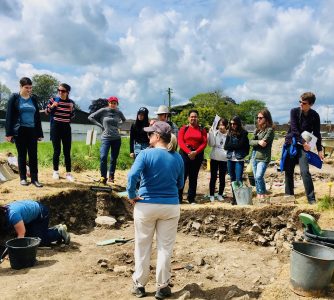
I’ve noticed that the COVID-19 pandemic sparked a growing interest in plagues and illnesses of the past, with people looking to history for advice on the present. Professor Alison More, a founding instructor of the Boyle Seminar, mentioned the revitalization of St. Corona in her own InsightOut post. She comments on how the saint, having had no previous association with plagues or illness, was now being called to intercede against a virus sharing her name. As More further elaborates with examples of St. Roche, St. Sebastian, and St. Rosalia of Palermo, the faithful repeatedly turn to saints for divine protection and guidance throughout the centuries.
Notably, for better or for worse, the prejudices, fears, and worries of the current pandemic are similar to those we have seen in the past. However, while we look to history for guidance, it’s crucial to incorporate the knowledge of the present. A course called Plagues and Peoples, which analyzed factors influencing the spread and survival of plague narratives, helped me hone the ability not only to read between the lines of a text, but out of them as well.
Essentially, the context surrounding narratives and what could have intentionally been left out reveal just as much information as what is present on the page. Ellen J. Amster has a great article detailing the persistence of prejudices and structural racism that are seemingly missing in these narratives, blinding subsequent generations to these darker aspects of history. Here, we note how the past is all but static and has the potential to be rewritten, though only as determined by those who hold the pen. Just as we have the ability to overlook these aspects, we also have the opportunity to learn from the past and change things for the better.
Perhaps the Mediaeval Studies Undergraduate Society (MSUS) has the pandemic and re-runs of Game of Thrones to thank for our numerous new members. In addition to students studying the Classics, History, and Christianity and Culture, we also have members in fields not commonly regarded as “mediaeval,” including Astrophysics, Human Biology, Ecology and Evolutionary Biology, as well as Cognitive Science. With little to no prior mediaeval studies experience, these students have taken an interest in something particular about the subject–be it language, myth, recipes, film, or music.
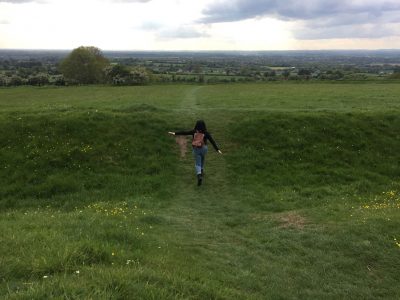
Mediaeval studies is special in that everyone can settle into their own respective niche. Gabrielle Camaoay, MSUS’ first-year representative and a fellow alumna of the Boyle Seminar, describes this rare ability, stating, “What drew me to mediaeval studies was the fact that it was so versatile, with so many subjects of study to choose from and being able to mix and match topics to your heart’s content.”
The subject of mediaeval studies is often misunderstood. I myself often have difficulty defining it. The university generalizes it as the study of the period between “roughly the fifth through the fifteenth centuries,” yet acknowledges that its “parameters are broad and boundaries are not clearly defined.” And perhaps this ambiguity is a benefit; the period is so varied and resilient that everyone can find common ground somewhere.
We become engrossed by the mediaeval world because we can see parts of ourselves in it, and we study it with the end goal of bridging the gap between the centuries by determining exactly how the past has helped shape the present.
So is it so wrong to live in the past? To be enamoured with what once was? I’d like to think not. There’s still so much left to learn, and with emerging technologies becoming more readily available, the possibilities for new discoveries are endless.
The past is alive. History is alive. It’s dynamic, eye-opening, and rapidly expanding. The Middle Ages are revived with each set of eyes laid on the folio of a manuscript, and every time a mediaeval fable is retold. Likewise, we can feel the mediaeval world within the classrooms of the University of St. Michael’s College, witnessing how it is renewed by the chronically curious students who breathe life into it.
Works Referenced
Radini, A, M Tromp, A Beach, E Tong, C Speller, M McCormick, J V Dudgeon, et al. 2019. “Medieval Women’s Early Involvement in Manuscript Production Suggested by Lapis Lazuli Identification in Dental Calculus.” Science Advances 5 (1): eaau7126–eaau7126. https://doi.org/10.1126/sciadv.aau7126
Read other InsightOut posts.
A new memorandum of understanding between the University of St. Michael’s College, the University of Toronto, and the Pontifical Institute of Mediaeval Studies (PIMS) heralds a renewed spirit of collaboration, says Dr. David Sylvester, President and Vice-Chancellor of the University of St. Michael’s College.
“This is much more than a piece of paper,” says Sylvester, who adds that having St. Mike’s Mediaeval Studies program, PIMS and U of T’s Centre for Medieval Studies all located in one city makes Toronto North America’s centre for research and study in the field. “[The MoU] reflects a new commitment from St. Mike’s to work with PIMS and U of T, and it opens doors to exciting possibilities for new cooperation.”
Dr. John Magee, who signed the MoU on behalf of U of T’s Centre for Medieval Studies (CMS), agrees.
“This is a starting point for future building and development,” explains Magee, who is a member of U of T’s Classics Department and the Collaborative Program in Ancient and Medieval Philosophy, as well as a Senior Fellow at PIMS. He assumes the role of Director of the Centre for Medieval Studies this coming July.
The five-year memorandum formally expresses a commitment on the part of the three signatories to work together to further engage with the mediaeval period through research, teaching, and publication. While each party remains distinct, the agreement suggests possibilities such as joint academic seminars or colloquia, as well as scholarly collaboration. It also notes that the PIMS library collection will continue to be housed in the John M. Kelly Library at St. Mike’s.
As a repository library with rare, non-circulating works, the PIMS library draws students from around the world to study everything from paleography to Latin, notes Sylvester.
Annual meetings will see the three parties discuss areas of mutual interest, opportunities for further engagement, and operational issues.
The agreement comes as the undergraduate Mediaeval Studies program, delivered at St. Mike’s as a sponsored program from Faculty of Arts and Sciences, is flourishing, and Sylvester notes that PIMs has “welcomed our undergrads with open arms,” inviting them to be part of the PIMS community.
Other natural “cross fertilization” sees PIMS’ Mellon Fellows teaching undergraduate students at St. Mike’s, for example, while PIMS has offered teaching and office space to St. Mike’s professors and students, adds Sylvester.
“This document summarizes the historic tripartite relationship between PIMS, St. Michael’s, and U of T and reflects people’s intentions going forward,” says PIMS Praeses (president) Dr. Richard Alway. “It builds on relationships in new ways and can be developed further.”
The first humanities research institute in Canada, PIMS was founded under the auspices of St. Michael’s and the Basilian Fathers in 1929, and was decreed a pontifical institute in 1939, notes Alway. From 1958 to 2005, it was a graduate school and research centre within St. Michael’s, but governance changes at the university saw PIMS establishing independent status to maintain its standing as a pontifical institute.
In addition to its world-class library, which Alway labels “a jewel, a centrepiece of our research,” and the post-doctoral Mellon Fellowships, PIMS also hosts a vibrant publishing program which produces about ten scholarly works a year, he notes, all added draws for mediaeval scholars.
“These are exciting times. St. Michael’s remains committed to undergraduate mediaeval studies, and students are attracted to what our professors and our supportive community can offer,” says Sylvester. “Our continuing goal is to build even more synergy with these important partners, precisely at this time when students and society are rediscovering the importance and the beauty of studying the humanities.”

